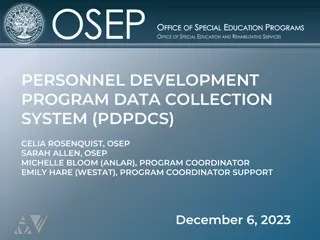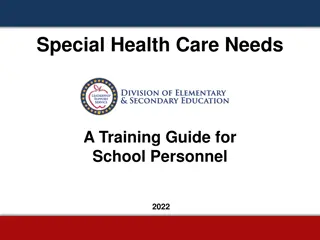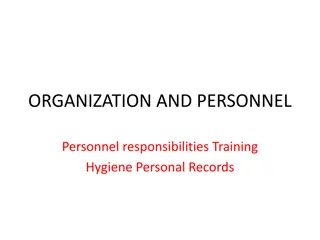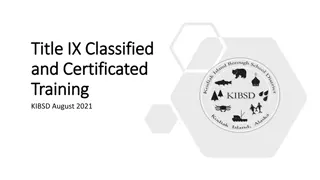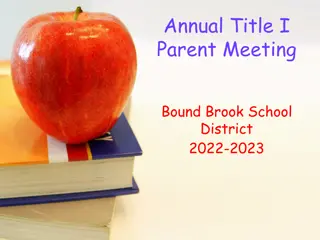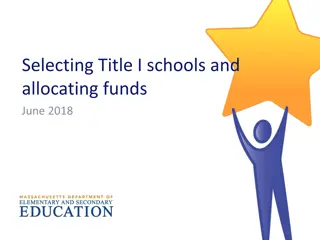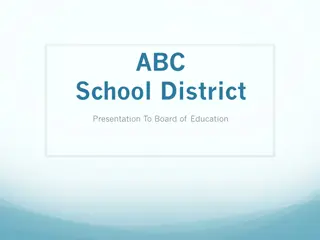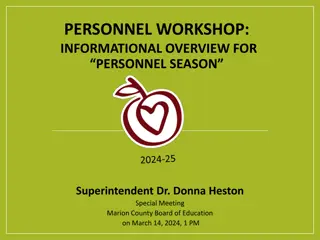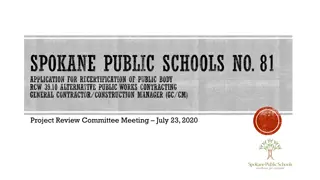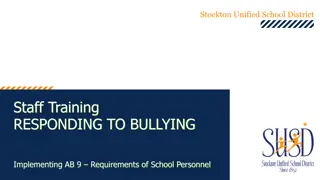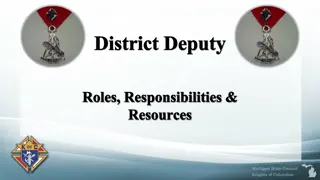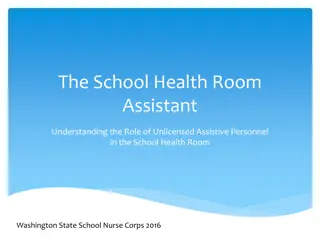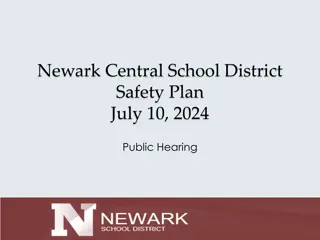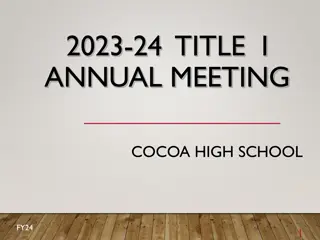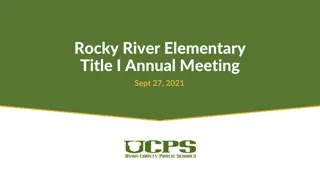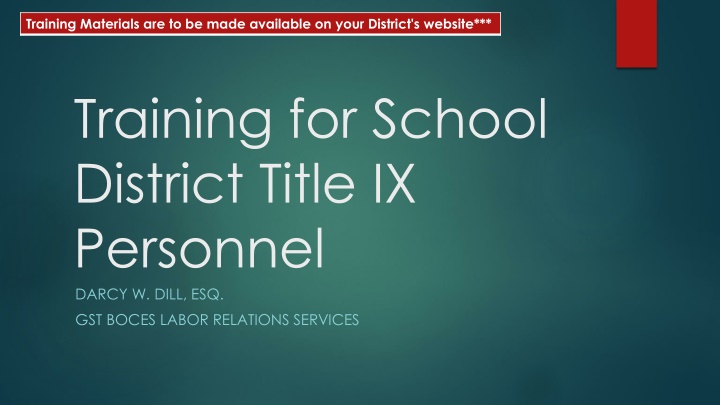
Understanding Title IX: Education Amendments of 1972
Explore the essential information about Title IX: the scope, prohibition of sex-based discrimination, intersection with other laws, burden of proof, and more. Learn about the requirements for schools and the protection it offers to students and staff.
Download Presentation

Please find below an Image/Link to download the presentation.
The content on the website is provided AS IS for your information and personal use only. It may not be sold, licensed, or shared on other websites without obtaining consent from the author. If you encounter any issues during the download, it is possible that the publisher has removed the file from their server.
You are allowed to download the files provided on this website for personal or commercial use, subject to the condition that they are used lawfully. All files are the property of their respective owners.
The content on the website is provided AS IS for your information and personal use only. It may not be sold, licensed, or shared on other websites without obtaining consent from the author.
E N D
Presentation Transcript
Training Materials are to be made available on your District's website*** Training for School District Title IX Personnel DARCY W. DILL, ESQ. GST BOCES LABOR RELATIONS SERVICES
Introduction to Title IX Title IX of the Education Amendments of 1972 provides, in part, that: no person in the United States shall, on the basis of sex, be excluded from participation in, be denied the benefits of, or be subjected to discrimination under any education program or activity receiving Federal financial assistance. . . . 20 U.S.C. 1681(a) What it prohibits: funded at all levels Discrimination based on sex in ALL educational programs and activities that are federally What it does: Protects both students and staff from being effectively denied access to educational program or activities because of harassment or discrimination Application of Title IX (it is more than sports): Recruitment Admissions Counseling Athletics Benefits, Opportunities Discipline and employment Sexual Harassment prohibits sexual harassment at school by peers, employees, third parties
Scope of Education Program and Activities in your School Includes school-sponsored activities School approved and/or funded activities or programs School-sponsored or approved travel Locations or activities that are under substantial control of the school district In the United States** ** denotes proposed regulatory change
Title IX - Intersection with other laws and policies Remember School Districts also must comply with other laws and district policies Violation of Title IX may not be found, but there may be violations of: NYS DASA (students protected from harassment, bullying, and discrimination in school) offers broad protection NYS Human Rights law (applicable to staff and students) o More protective in some ways (standard to find violation is if substantially impairs education or employment) Title VII (applicable to staff) Federal law Codes of Conduct
Title IX - When are schools required to act? What is the Burden of Proof? Must have ACTUAL knowledge of sexual harassment before must respond Response must be prompt and not deliberately indifferent (or unreasonable in light of the known circumstances). 34 CFR 106.44. Actual knowledge means any notice of sexual harassment or allegations of sexual harassment to a recipient s Title IX Coordinator or any employee Burden of Proof options for schools to adopt: Preponderance of the Evidence Standard (51%+) OR Clear and Convincing Evidence (more rigorous high probability of truth ) o Apply the same standard of evidence for formal complaints against students as for formal complaints against employees. **NOTE: proposed regulatory change to establish POE standard, unless clear and convincing used in like proceedings o
Title IX Personnel and Roles Title IX Coordinator Available to receive formal complaints Can sign formal complaint himself/herself Must promptly contact complainant to discuss availability of supportive measures (with or without filing formal complaint) Must advise of formal complaint process Implement supportive measures with complainant and respondent Implement determination of decision maker Title IX Coordinator can also be investigator (but not decision maker) ** Title IX Coordinator receives initial evidence and report and provides to parties/allows for additional questions from parties ** Your school must prominently display the name, title, office address, email address, and telephone number of the Title IX Coordinator. This information must be available on your district website (with the non- discrimination statement) and in employee/student handbooks.
Title IX Personnel and Roles Investigators Promptly investigate allegation of sex discrimination under Title IX Collects relevant evidence Send out notices regarding status of investigation ** Fairly summarize relevant evidence in investigatory report Can also be the Title IX Coordinator (but not the decision maker) ** Decision-Makers Prepares written decision and sends simultaneously to both parties Written decision has specific components (addressed later)
Title IX Personnel - Mandatory Expectations Separation of Duties Regulations prohibit a single-investigator model. This means the investigator and decision maker must be different individuals ** All three duties can be occupied by different person Expectations of ALL Title IX Personnel Must serve impartially and maintain equity among parties No conflicts of interest E.g. relationships of friendships; personal benefit to be derived from acting in official capacity; confidential information on one party; financial interest No bias Human reaction mostly unconscious. Prejudice or preference in favor or against one thing; a lack of objectivity; notions or ideas going into a matter E.g. having common connections or interest; expressing these commonalities No sex stereotypes Avoid prejudgment of facts at issue
District Title IX policy and non- discrimination statement required Updated Title IX policies must be implemented with mandated requirements: Designate Title IX Coordinator with roles/responsibilities Define sexual harassment and formal complaint **( formal complaint ) Process for responding to formal complaint (grievance process) ** Training requirements ** Potential sanctions to be imposed when affirmative finding of sexual harassment Evidentiary Standard ** Publish a notice of nondiscrimination
What is Sexual Harassment under Title IX? Sexual Harassment Defined Sexual harassment means conduct on the basis of sex that satisfies one or more of the following: An employee of the recipient conditioning the provision of an aid, benefit, or service of the recipient on an individual's participation in unwelcome sexual conduct; or 1) Unwelcome conduct determined by a reasonable person to be so severe, pervasive, and objectively offensive that it effectively denies a person equal access to the recipient's education program or activity; or 2) **NOTE: Proposed regulatory change to severe or pervasive that based on totality of circumstances and evaluated objectively and subjectively limits ability to participate in education program or activity Sexual assault as defined in [the Clery Act], dating violence as defined in [the Violence Against Women Act ( VAWA )], domestic violence as defined in [VAWA], or stalking as defined in [VAWA]. 3) 34 C.F.R. 106.30(a)
Responding to Actual Notice of Sexual Harassment How is a complaint made? Formal document** filed by complainant alleging sexual harassment against respondent and requesting investigation filed with Title IX Coordinator or any employee Informal document or verbal statement filed with the Title IX Coordinator or any employee Title IX Coordinator can take a verbal statement and put into formal complaint** form and ask complainant to sign or Coordinator can sign. Whether the person files a formal complaint,** a Title IX Coordinator must: Offer supportive measures Advise the person of his or her right to file a formal complaint Provide the person with information about how to file a complaint Still do an investigation, as other laws/policies still in play (e.g. New York State Human Rights law, DASA, Title VII, Codes of Conduct)
Supportive Measures Supportive measures are non-punitive** individualized services offered as appropriate, as reasonably available, and without fee or charge to the complainant or the respondent before or after the filing of a formal complaint or where no formal complaint has been filed. Supportive measures restore or preserve equal access to the education program or activity without unreasonably burdening the other party, including measures designed to protect the safety of all parties or the recipient's educational environment, or deter sexual harassment. Examples of supportive measures include: Counseling; deadline extensions and course adjustments; modified class schedules; escort services; mutual restrictions on contact between the parties; housing or work adjustments; leaves of absence; increased security for certain areas of campus; and similar measures. Any supportive measures that a school provides to either party must be kept confidential to the extent that confidentiality does not prevent the school from effectively offering the supportive measures themselves. The Title IX Coordinator is responsible for coordinating the effective implementation of supportive measures.
Emergency Removals Presumption that Respondent is not responsible for alleged misconduct BUT District can remove a Respondent from an educational program or activity, provided a risk analysis has been performed and determination made that a threat to physical safety of any student or other individual arising from alleged sexual harassment exists to justify the removal. AND The Respondent was notified and had an opportunity to challenge the decision immediately following his/her removal.
Formal Complaints ** Official document alleging sexual harassment Signed/filed by: Complainant, parent or guardian Can be signed by Title IX Coordinator even though wishes of Complainant are different. If facts are such that need to investigate so that the District is not deliberately indifferent, then the Title IX Coordinator is empowered with the authority to start the formal process Impact of filing formal complaint: Triggers grievance process **Proposed regulations modify such that grievance process is triggered by written or verbal complaint; no formal complaint requirement.
Grievance Process Generally Must be reasonably prompt to equitably resolve complaint Must follow grievance process before impose disciplinary sanctions Must be made available to staff and students Follow these Principles: Treat parties equitably Gather relevant evidence Provide supportive measures to BOTH parties throughout Standard of Evidence selection select one (POE or CC) ** Presume Respondent is innocent until final determination ** still presumption; but supportive measures that burden Respondent are acceptable during pendency of process
First Step after receipt of Formal Complaint:** Start an Investigation Notice #1 goes out to BOTH complainant and Respondent Notice of grievance process Notice of alleged sexual harassment allegations and sufficient details that are known at that time Identify the parties involved in the incident Identify conduct constituting sexual harassment, the date and location Investigator will contact you soon to set up an interview Inform of any provision in the Employee/Student Code of Conduct regarding a prohibition to make false statements as part of grievance process Right to representation/advisor of his/her choosing, can be attorney
Investigation Appoint an investigator (not the Decision Maker) Notice # 2 goes out to individual parties by investigator setting up meetings. Provide notice that parties have right to representation or advisor of their choosing during questioning. Timing: sufficient time for parties to prepare Accept all relevant evidence (inculpatory and exculpatory) Relevant Evidence: Evidence that is pertinent to providing whether facts material to allegations are more or less likely to be true CAN INCLUDE: party statements, witness statements, other evidence; CANNOT INCLUDE: privileged info Objective evidence/corroborating evidence is only limited by requirement to complete investigation in reasonably prompt time frame
Investigation Best Practices Be prompt, thorough and impartial Start with the Complainant and clarify allegations Request and secure any video evidence Request copy of personnel or student file of Complainant and Respondent Interview complainant and all witnesses who, what, where, when, and why Interview Respondent who, what, where, when, and why Respondent s rights Cadet rights, Weingarten rights and Garrity Rights explicitly stated(or get a written waiver if waiving union representation) Do NOT restrict right of parties to ask questions of others; to present own witnesses Parties have right to present their own evidence Parties have the right to discuss the allegations with others Questions regarding Complainant s sexual predisposition or prior sexual behavior are not relevant unless offered to prove alternate offender or to prove consent
Next Step: Finalizing Investigation Notice #3 out to parties by investigator Advise them that investigation is near complete Provide parties with opportunity to review and respond to all relevant evidence within next ten (10) days before investigation is complete Title IX Coordinator acts provides evidence and collects responses Response is in writing Prepare Investigatory Report (Document #4) Investigatory Report should: Include background information (referral and credential of investigator) Investigative summary with: Initial complaint/statement of allegations Appliable BOE policies Interviews and statements collected Documentary evidence and records Findings Send out investigatory report with statement that the parties have ten (10) days to respond to the contents of this report before the same is sent to the District s Decision Maker for his/her final determination. Send out report simultaneously to Complainant and Respondent Opportunity of each party to submit written questions of others after investigative report submitted, but before determination of responsibility (can be provided within same 10-day response window) District has the option to implement Due Process hearing per policy (not mandated)
Next Step: Determination by Decision Maker Decision Maker must issue written decision and finding of facts (Document #5) Components of Final Decision ( Determination of Responsibility ) Whether district s policies have been violated - A description of procedural steps followed - Standard of Evidence applied (clear and convincing or POE) - Finding of Facts - Conclusions - Rationale - Disciplinary Sanctions to Respondent or Remedy(ies) for Complainant (as applicable) - District s Title IX Procedure and Statement of Right to Appeal - You have the right to appeal the findings of this determination by following the District s Title IX appeal process located in the Board of Education Title IX policy available on our District s website. You have a right to appeal for the following reasons: a) a procedural irregularity lead to an improper outcome; b) there is new evidence that was not reasonably available previously; or c) you believe the Title IX Coordinator, investigator, or Decision Maker acting on behalf of the District had a conflict of interest or bias that affected the outcome. - Send Decision to both parties simultaneously -
Appeals & Remedies and Sanctions Only AFTER Decision Maker makes Determination of Responsibility Either party can appeal by following appeals procedure with timelines established by the District Bases to appeal: (1) Procedural irregularity (2) New evidence that was not available when determination made (3) Title IX Coordinator, investigator, or DM had conflict of interest or bias If there is an affirmative determination of responsibility, implement remedies and sanctions o The Title IX Coordinator is responsible for implementing such remedies and sanctions. o Must make all students and staff aware of possible remedies and sanctions (policy) o Remedies for the Complainant Can be individualized services like supportive measures o Designed to restore and preserve equal access to education program/activity o Discipline of Respondent o Discretion left to the District o
Mandatory or Permissible Dismissals If formal complaint is filed, there is an obligation to start investigation AND provide Notice #1 (Respondent must be notified, even if complaint may be dismissed as futile ) Mandatory Dismissals Must dismiss a complaint that: Does not describe conduct that meets definition of sexual harassment Alleges sexual harassment that does not occur in the U.S. Alleges sexual harassment that did not occur in educational program/activity Permissive Dismissals May dismiss a complaint that: Complainant wants to withdraw the formal complaint; Respondent is not enrolled or employed by the District; or Circumstances prevent District form gathering sufficient evidence to reach a determination about the allegations **NOTE: Proposed regulations only include permissive dismissals If dismiss complaint, must provide written notice to parties Rights to appeal dismissal
Retaliation Prohibited; Confidentiality Retaliation Prohibited Intimidation, threats, coercion, or discrimination, including charges against an individual for code of conduct violations that do not involve sex discrimination or sexual harassment, but arise out of the same facts or circumstances as a report or complaint of sex discrimination, or a report or formal complaint of sexual harassment, for the purpose of interfering with any right or privilege secured by title IX or this part, constitutes retaliation. 34 C.F.R. 106.71(a) Confidentiality [E]xcept as may be permitted by [FERPA], or as required by law, or to carry out the purposes of Title IX, including the conduct of any investigation, hearing, or judicial proceeding arising thereunder, schools must preserve confidentiality for anyone who has made a report or complaint of sex discrimination (including anyone who has reported or filed a formal complaint of sexual harassment); any complainant; any individual who has been reported to be the perpetrator of sex discrimination; any respondent; and any witness. . . . 34 C.F.R. 106.71(a).
Record Keeping is Required A recipient must maintain for a period of seven years records of: Investigation file and determination of responsibility (including any audio/AV recordings or transcripts), disciplinary sanctions imposed, remedies provided Any appeal and the result of such appeal Any informal resolution and the result of such resolution All materials used to train Title IX staff. All training materials must be made publicly available on recipient s website



